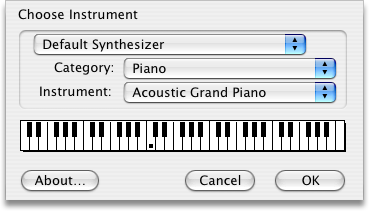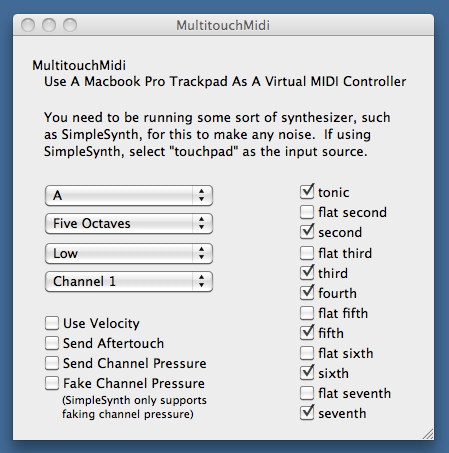- MIDISimpleSynth:5: error: expected constructor, destructor, or type conversion before ';' token MIDISimpleSynth.ino: In function 'void setup': MIDISimpleSynth:89: error: 'MIDI' was not declared in this scope MIDISimpleSynth.ino: In function 'void loop': MIDISimpleSynth:96: error: 'MIDI' was not declared in this scope.
- (experimental) Create a standard Yarn synth action. Uses yarn install -frozen-lockfile to install dependencies and npx cdk synth to synthesize. If you need a build step, add buildCommand: 'yarn build'.
PURE DATA
SimpleSynth A small, fast synth, for trying out musical ideas quickly. Theme based on Dinky. Entypo icons by Daniel Bruce.
- INTRODUCTION
- INSTALLING
- GETTING STARTED
- THE INTERFACE
- AUDIO TUTORIALS
- DATAFLOW TUTORIALS
- VIDEO (GEM) TUTORIALS
- SENSORS
- NETWORK DATA
- MIDI
- STREAMING
- LIST OF OBJECTS
- APPENDICES

PureData: SimpleSynthIntroduction

This tutorial uses the concept of simple electronic musical instruments to introduce some of the core concepts of synthesizing and processing audio in Pure Data. Those who are already familiar with audio synthesis should quickly grasp how it works in Pd, while those with no previous knowledge will be introduced to its theory alongside its practical application in Pd.
The MiniMoog is one of the most famous analog synthesizers in the world. We'll take a shot at reproducing some of its basic features in this tutorial. Source: http://en.wikipedia.org/wiki/Image:Minimoog.JPG

A synthesizer is one of the most fundamental instruments in electronic music. Its essential function is to generate a musical tone when it receives a note from either a keyboard or a sequencer. In analog electronic music, a synthesizer is built from several modules, or parts:
- The Oscillators, which generate the tones.
- The LFO (Low Frequency Oscillator), which usually modulates either the frequency or gain of the Oscillator(s), or the frequency of the Filter.
- The Filter, which emphasizes and/or removes certain frequencies.
- The Envelope Generator, which controls changes in frequency or gain over the duration of the note.
- The Amplifier, which controls the gain of the synthesizer.
Synthesizers can be capable of playing one note at a time (monophonic), or several notes at a time, allowing for chords (polyphonic). The number of simultaneous notes that a synthesizer can play are called its voices. Originally, the word 'Voltage' was used (i.e. Voltage Controlled Oscillator, Voltage Controlled Filter or Voltage Controlled Amplifier) because in an analog synthesizer each of these modules was controlled by electrical voltage from the keyboard, sequencer or another module. Because we're working in the digital domain, this voltage is replaced by data in the form of numbers, messages and streams of digital audio.
For this tutorial, we will construct a monophonic synthesizer in Pd based roughly on the design of the famous MiniMoog analog synthesizer (but much simpler!), and with a sound which is useful for generating basslines. It will take input from the computer keyboard, a MIDI keyboard or the sequencer we will build in the the next tutorial. This synthesizer will be based on two Oscillators to produce the note, another oscillator (the Low Frequency Oscillator) which will change the gain of the sound, a Filter which will only allow only certain frequencies of the sound to pass, an Envelope Generator which will control the 'shape' of the gain of the note, and a final Amplifier which will be controlled by the Envelope Generator and a volume setting on the screen.
Examples
The following chapters contain many examples of PD patches that you can create for yourself using the techniques described in the interface chapter. Doing so will give you practice at using the editor and prepare you to start making your own creations.
Hello my friends,
As I was talking to Grumpy Mike in other topic, I need help to build some controllers to my studio. I´m newbie in electronics and I´m having my very first experiences with arduino, then I need some orientation even to study things better.
I gonna explain everything I want to do then you guys can give me some suggestion for where I should start.
My intention is to build 3 or 4 controllers to be able to control the parameters of my virtual audio tools with potentiometers and pushbuttons.
Each controler will have around 24... 30 potentiometers and 8 or 10 pushbuttons.
Simplesynthaction
My intention is to build it using the Arduino Uno with the Mux Shield II.
Osx Simplesynth
The first test I did with the arduino was using a crap 'instructiables' sketch. This code was depedent of two softwares, MIDI YOKE and SERIAL MIDI CONVERTER. I have nothing against those softwares... but the problem is, the Serial Midi Converter I have to open and set it up everytime I use the controller. I need something that I can save the setup and use always I want. Or if possible to build a project that doesn´t need those external softwares would be great..
Another Issue is that I use Windows 8.1 x64 on my studio and both softwares Midi Yoke and Serial Midi doesn´t work in that version. I did some tests with those softwares in other computer x32 based.
Grumpy Mike said to me that the only way to not depend on that extra softwares is to use midi ports on the arduino, conected to a real midi interface. Ok I have that option, coz I do have true midi conections at my audio interface. As I said before my intention is to build 3 or 4 controllers. Then I would like to know which is the best way to do it... if use all the controllers through USB or MIDI conection.
I need some suggestions for where I could start.... Would possible to do a sketch to make arduino works like a midi controller through the usb port? I see many equipments in the market today are able to control the softwares and they are only USB conection, working without any external software. I can use an external software if it´s necessary... but I´m just looking for the best and stable way to do it.
Simple Synth Windows

Well that´s it... too long post already! :fearful:
Fl Studio Synth
Hope someone can give me some tips for the best way to build that project and to study the codes.
Thanks a lot!
